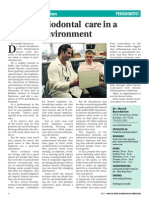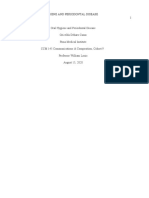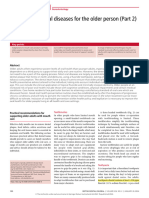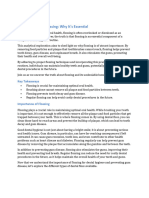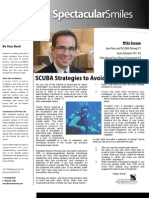0 ratings0% found this document useful (0 votes)
84 viewsPatient 08 PDF
Patient 08 PDF
Uploaded by
amarCopyright:
© All Rights Reserved
Available Formats
Download as PDF, TXT or read online from Scribd
Patient 08 PDF
Patient 08 PDF
Uploaded by
amar0 ratings0% found this document useful (0 votes)
84 views1 pageOriginal Title
patient_08.pdf
Copyright
© © All Rights Reserved
Available Formats
PDF, TXT or read online from Scribd
Share this document
Did you find this document useful?
Is this content inappropriate?
Copyright:
© All Rights Reserved
Available Formats
Download as PDF, TXT or read online from Scribd
Download as pdf or txt
0 ratings0% found this document useful (0 votes)
84 views1 pagePatient 08 PDF
Patient 08 PDF
Uploaded by
amarCopyright:
© All Rights Reserved
Available Formats
Download as PDF, TXT or read online from Scribd
Download as pdf or txt
You are on page 1of 1
F O R T H E D E N TA L PAT I E N T . . .
including the color and firmness of the gums. A
Preventing very small instrument called a periodontal probe
is used to gently measure the space between the
periodontal disease teeth and gums. This determines whether perio-
dontal pockets are present. The normal space be-
tween teeth and healthy gums should be three
millimeters or less. Generally, the more advanced
y the time people reach adulthood, the gum disease, the greater the pocket size.
B their teeth and gingivae, or gums, have
had quite a workout. When gums are
healthy, they continue to fit snugly
around the teeth. Many adults, how-
ever, develop some type of periodontal, or gum,
diseasean infection of the tissues that support
their teeth.
Except in unusual cases, you can help prevent
gum disease by brushing twice a day and cleaning
between your teeth with floss or an interdental
cleaner once a day. Choose products that display
the ADA Seal of Acceptance, your assurance that
they meet the ADAs criteria for safety and effec-
tiveness. Your dentist may provide additional
Some researchers suggest that there may be a instructions on cleaning methods or products you
link between gum disease and other health con- can use at home. Avoiding tobacco use and other
cerns such as cardiovascular problems, stroke, healthy measures, such as eating a balanced diet,
bacterial pneumonia and increased risk during are important in preventing periodontal disease.
pregnancy. More studies are needed to determine Even if you brush and floss regularly, you may
if the bacteria or the inflammatory response asso- not remove all the plaque, especially around the
ciated with gum diseases play a role in these sys- gumline. Plaque can harden into a rough, porous
temic problems. deposit called calculus or tartar. Once hardened,
it can be removed only in the dental office during
CAUSES
your regular cleaning.
Gum disease is usually caused by plaque, a sticky
WARNING SIGNS
film of bacteria that constantly forms on teeth. If
plaque is not removed with thorough daily You may not even be aware that you have gum
brushing and cleaning between teeth, gums disease because often there is no pain. There are
become irritated and inflamed. The irritated gum warning signs, however, and you should call your
tissue can separate from the teeth and form dentist if you experience any of the following:
spaces called pockets. Bacteria move into the dgums that bleed during brushing;
pockets, where they continue to promote irrita- dred, swollen or tender gums;
tion. Left untreated, the process can continue dgums that have pulled away from the teeth;
until the bone and other tooth-supporting tissues dpersistent bad breath;
are destroyed. dpus between the teeth and gums;
The early stage of periodontal disease is called dloose or separating teeth;
gingivitis. It often results in gums that are red da change in the way your teeth fit together
and swollen and may bleed easily. The good news when you bite;
is that this early stage is usually reversible. da change in the fit of partial dentures.
Sometimes, all it takes are more regular profes-
sional cleanings and better home care.
Prepared by the ADA Division of Communications, in cooperation
PREVENTION with The Journal of the American Dental Association. Unlike other
portions of JADA, this page may be clipped and copied as a handout for
Regular checkups are important. During an patients, without first obtaining reprint permission from ADA Pub-
examination, your gums are evaluated for perio- lishing, a division of ADA Business Enterprises Inc. For the Dental
Patient was not developed to comply with legal requirements for
dontal disease. The dentist looks at many things, informed consent.
JADA, Vol. 132, September 2001 1339
Copyright 1998-2001 American Dental Association. All rights reserved.
You might also like
- Farmakologija - RangDocument813 pagesFarmakologija - Rangthis_is_m387% (39)
- (Early Modern Literature in History) Kathleen Miller (Auth.) - The Literary Culture of Plague in Early Modern England-Palgrave Macmillan Uk (2016) PDFDocument247 pages(Early Modern Literature in History) Kathleen Miller (Auth.) - The Literary Culture of Plague in Early Modern England-Palgrave Macmillan Uk (2016) PDFsomabswsNo ratings yet
- Ortega Miasms PDFDocument90 pagesOrtega Miasms PDFMd. Mahabub Alam100% (8)
- Treating Periodontal Diseases: For The Dental Patient ..Document1 pageTreating Periodontal Diseases: For The Dental Patient ..damien.thorn4294No ratings yet
- By Mayo Clinic Staff: Click To EnlargeDocument4 pagesBy Mayo Clinic Staff: Click To EnlargeLexie DvrelsNo ratings yet
- Iwst10 IktDocument6 pagesIwst10 Ikt9bgnyshtbhNo ratings yet
- What Is The Definition of Periodontitis?Document3 pagesWhat Is The Definition of Periodontitis?Sakshi RanaNo ratings yet
- ADA PatientSmart Preventing Perio PDFDocument4 pagesADA PatientSmart Preventing Perio PDFJoe WattimenaNo ratings yet
- What Does Perio Treatment InvolveDocument2 pagesWhat Does Perio Treatment InvolveGabriela ArgeseanuNo ratings yet
- Sdcep Information About Periodontitis A5 LeafletDocument2 pagesSdcep Information About Periodontitis A5 Leafletk.shehla208No ratings yet
- When To See A DentistDocument4 pagesWhen To See A DentistRudyXPNo ratings yet
- Periodontitis (Gum Disease) Causes, Symptoms, and Treatment 3Document1 pagePeriodontitis (Gum Disease) Causes, Symptoms, and Treatment 3tdyg96cxkhNo ratings yet
- HTTPDocument7 pagesHTTPErvic SitjarNo ratings yet
- Ultrasonic Scaling Before Tooth Brushing PDFDocument4 pagesUltrasonic Scaling Before Tooth Brushing PDFSarra TekayaNo ratings yet
- Periodontics: PeriodontitisDocument6 pagesPeriodontics: PeriodontitismarkoNo ratings yet
- Introduction To Gum DiseaseDocument7 pagesIntroduction To Gum DiseaseelizabethNo ratings yet
- UNDERSTANDING DENTITIONDocument18 pagesUNDERSTANDING DENTITION2godbthanksNo ratings yet
- Receding Gums: 1201 K Street, Sacramento, CA 95814 800.232.7645Document1 pageReceding Gums: 1201 K Street, Sacramento, CA 95814 800.232.7645Ina BogdanNo ratings yet
- Dental DiseaseDocument15 pagesDental Diseasetien280917No ratings yet
- Whoswho BNVER1 08Document1 pageWhoswho BNVER1 08ninotsdNo ratings yet
- Older Adults and Oral HealthDocument6 pagesOlder Adults and Oral HealthHilary HuynhNo ratings yet
- Oral Hygiene TipsDocument3 pagesOral Hygiene Tipsdr parveen bathlaNo ratings yet
- Definition GingivitisDocument7 pagesDefinition GingivitisverenNo ratings yet
- 2022 Factsheet Gum DiseaseDocument1 page2022 Factsheet Gum DiseaseKish BNo ratings yet
- Gingivitis PerioDocument2 pagesGingivitis PerioFeyza ÇETİNNo ratings yet
- Dental Hygiene and Periodontal DiseaseDocument7 pagesDental Hygiene and Periodontal Diseaseapi-536835901No ratings yet
- 6 Ways To Keep Your Gums HealthyDocument4 pages6 Ways To Keep Your Gums HealthyRoy PacNo ratings yet
- Presentation 1. Treatment Planning For The Immediate Denture 2. The Patient With Periodontal DiseaseDocument19 pagesPresentation 1. Treatment Planning For The Immediate Denture 2. The Patient With Periodontal DiseaseNika Permata DelaNo ratings yet
- GingivitisDocument2 pagesGingivitisPatricia MedeirosNo ratings yet
- nhs-info.doenca.bolsaperiodDocument3 pagesnhs-info.doenca.bolsaperiodIsabel Michelucci BrancoNo ratings yet
- Dental Health EbookDocument15 pagesDental Health EbooktmetscherNo ratings yet
- Oral Health-WPS OfficeDocument34 pagesOral Health-WPS OfficeChief ArisaNo ratings yet
- Oral Hygiene Medical Presentation by Pearl Dental ClinicDocument16 pagesOral Hygiene Medical Presentation by Pearl Dental ClinicDental ServicesNo ratings yet
- 2-Three Steps To Achieving Proper Oral HealthDocument3 pages2-Three Steps To Achieving Proper Oral HealthjpaNo ratings yet
- Oral Hygiene PosterDocument4 pagesOral Hygiene PosterEd edNo ratings yet
- Gingivitis EnglishDocument4 pagesGingivitis EnglishverenNo ratings yet
- Diabetes and Oral HealthDocument1 pageDiabetes and Oral HealthBeta KrisnanovitaNo ratings yet
- Unit 4 lesson 3Document61 pagesUnit 4 lesson 3shiruko9000No ratings yet
- A Client With A Full Time Caregiver Requiring Personal Hygiene and Has Tight Interproximal Contacts.Document24 pagesA Client With A Full Time Caregiver Requiring Personal Hygiene and Has Tight Interproximal Contacts.ritabagadiaNo ratings yet
- Jamainternal Nadanovsky 2024 VP 240004 1713804876.99769Document2 pagesJamainternal Nadanovsky 2024 VP 240004 1713804876.99769Kang Cheul KwonNo ratings yet
- In The Dental Implant Era, Why Do We Still Bother Saving Teeth?Document8 pagesIn The Dental Implant Era, Why Do We Still Bother Saving Teeth?Gabriela ArgeseanuNo ratings yet
- Periodontal DiseaseDocument4 pagesPeriodontal DiseaseAndika SulistianNo ratings yet
- Secrets Your Dentist Doesn't Want You To KnowDocument6 pagesSecrets Your Dentist Doesn't Want You To Knowscott38w2727100% (1)
- Prevention of Oral Diseases For The Older Person (Part 2) : ClinicalDocument5 pagesPrevention of Oral Diseases For The Older Person (Part 2) : ClinicalFatima AliNo ratings yet
- British-Orthodontic-Society-InterproximalReduction2024Document2 pagesBritish-Orthodontic-Society-InterproximalReduction2024gird magroodNo ratings yet
- nhs-gengiv.perodonto.ilustraDocument16 pagesnhs-gengiv.perodonto.ilustraIsabel Michelucci BrancoNo ratings yet
- Perio Paper FinalDocument6 pagesPerio Paper Finalapi-546518451No ratings yet
- What Is Gingivitis - Treatment & PreventionDocument1 pageWhat Is Gingivitis - Treatment & Preventionzohsyd21No ratings yet
- Gingivitis Vs PeriodontitisDocument2 pagesGingivitis Vs Periodontitisandreas kevinNo ratings yet
- Cover Front Cover: 0eriodontal 'Um $iseaseDocument16 pagesCover Front Cover: 0eriodontal 'Um $iseaseam31_applezNo ratings yet
- Importance of Oral Hygiene: Why Is Oral Health Important? What Is A Cavity?Document2 pagesImportance of Oral Hygiene: Why Is Oral Health Important? What Is A Cavity?clrssNo ratings yet
- nhs-quandoper-titeDocument2 pagesnhs-quandoper-titeIsabel Michelucci BrancoNo ratings yet
- A4 UK TeethDocument4 pagesA4 UK TeethkeluargaNo ratings yet
- Dental Care and Oral HealthDocument13 pagesDental Care and Oral HealthNasroNo ratings yet
- The Truth About Flossing - Scribd 270423Document5 pagesThe Truth About Flossing - Scribd 270423KazeemNo ratings yet
- Articulo Materiales DentalesDocument3 pagesArticulo Materiales Dentaleskarla verjanNo ratings yet
- Pamantasan NG Lungsod NG MaynilaDocument15 pagesPamantasan NG Lungsod NG MaynilaAlex HollandNo ratings yet
- Dental CariesDocument14 pagesDental CariesLexina AdjeiNo ratings yet
- Prevention of Gum Disease: Your Oral HealthDocument3 pagesPrevention of Gum Disease: Your Oral HealthmebibegNo ratings yet
- Salud PDFDocument16 pagesSalud PDFDulce MartinezNo ratings yet
- Spectacularsmiles: New Spectacular Smiles!Document4 pagesSpectacularsmiles: New Spectacular Smiles!burlesonddsNo ratings yet
- 4 Facts To Know About Teen's Gum Disease'sDocument13 pages4 Facts To Know About Teen's Gum Disease'sdryasminkottaitpediatricdentistNo ratings yet
- ProDentim Review - How To Cure Gum Disease ?: How To Cure Tooth Decay Naturally....!!From EverandProDentim Review - How To Cure Gum Disease ?: How To Cure Tooth Decay Naturally....!!No ratings yet
- Jepsen 2017Document9 pagesJepsen 2017amarNo ratings yet
- Slzer 2017Document10 pagesSlzer 2017amarNo ratings yet
- Apb 5 373Document5 pagesApb 5 373amarNo ratings yet
- Regulated Wnt/Beta-Catenin Signaling Sustains Adult Spermatogenesis in MiceDocument12 pagesRegulated Wnt/Beta-Catenin Signaling Sustains Adult Spermatogenesis in MiceamarNo ratings yet
- Bronchial Asthma Pulmonary Oedema (Cardiac Asthma) : Avoid .AvoidDocument1 pageBronchial Asthma Pulmonary Oedema (Cardiac Asthma) : Avoid .AvoidjincymariyamNo ratings yet
- Understanding The Causes of MeaslesDocument7 pagesUnderstanding The Causes of MeaslesiyanNo ratings yet
- IHR Monitoring Framework Checklist and IndicatorsDocument69 pagesIHR Monitoring Framework Checklist and IndicatorsCrismarie AlvarezNo ratings yet
- Begs 183Document4 pagesBegs 183viploveNo ratings yet
- Test On Word Formation 12Document3 pagesTest On Word Formation 12Mirela GrosuNo ratings yet
- Critical Health Literacy: A Case Study From China in Schistosomiasis ControlDocument6 pagesCritical Health Literacy: A Case Study From China in Schistosomiasis ControlLucas TobingNo ratings yet
- Informal LetterDocument2 pagesInformal LetterAQILAH NASUHA BINTI ABDULLAH SANI MoeNo ratings yet
- Manhattan Test 1Document43 pagesManhattan Test 1Chen CgNo ratings yet
- Zygomatic Implants PDFDocument18 pagesZygomatic Implants PDFgirl33No ratings yet
- Biologi Bordetella PertussisDocument7 pagesBiologi Bordetella PertussisSetyadinda Putri MalindaNo ratings yet
- Environmental Practicum Report Second DraftDocument30 pagesEnvironmental Practicum Report Second Draftapi-295271022No ratings yet
- Commissioned Officer's HandbookDocument133 pagesCommissioned Officer's HandbookBONDCK88507100% (2)
- Soal News Item TextDocument4 pagesSoal News Item Textnk9618478No ratings yet
- Tropical Diseases Travel Health 2013-14: Lesions in Returning Travellers. Examples Include Cutaneous LeishmaniasisDocument2 pagesTropical Diseases Travel Health 2013-14: Lesions in Returning Travellers. Examples Include Cutaneous LeishmaniasisLeyla MajundaNo ratings yet
- Acute Laryngotracheobronchitis (Croup) : HistoryDocument5 pagesAcute Laryngotracheobronchitis (Croup) : HistoryJesus Reynaldo Campos MartinezNo ratings yet
- Excerpts From Kuby ImmunologyDocument2 pagesExcerpts From Kuby ImmunologyDavid Saguil100% (1)
- MESU-EO Buenavista QuezonDocument2 pagesMESU-EO Buenavista QuezonChristian Lawrence ReyesNo ratings yet
- Lymphogranuloma Venereum 'At A Glance: EpidemiologyDocument6 pagesLymphogranuloma Venereum 'At A Glance: EpidemiologyRezki Purnama YusufNo ratings yet
- Helm in TH OlogyDocument42 pagesHelm in TH OlogyNiaz Asghar75% (4)
- Virus Notes - EXE PDFDocument129 pagesVirus Notes - EXE PDFsweta yadav100% (1)
- The Woman Speaks To The Man Who Has Employed Her Son': Yl:english LiteratureDocument12 pagesThe Woman Speaks To The Man Who Has Employed Her Son': Yl:english LiteratureAngel LawsonNo ratings yet
- CURS - ENGLEZA - Boli Infectioase PDFDocument246 pagesCURS - ENGLEZA - Boli Infectioase PDFLesan IulianaNo ratings yet
- RKUD2999Document34 pagesRKUD2999Nabila AzharNo ratings yet
- Hema 1 Quiz FinalsDocument2 pagesHema 1 Quiz FinalsChristian John Mabalot CarilloNo ratings yet
- Situation Analysis of Health CareDocument32 pagesSituation Analysis of Health CareSonia AsyrifaNo ratings yet
- QuizDocument3 pagesQuizYel Balmediano Dela Cruz0% (1)
- Theories in MortalityDocument95 pagesTheories in MortalityTere MapiliNo ratings yet
- Bladder Outlet Obstruction in Children PDFDocument64 pagesBladder Outlet Obstruction in Children PDFalaaNo ratings yet



















